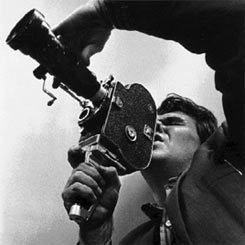Stan Brakhage Showcase
Dec 06, 2012
(Multiple films, 16mm, 1955-1994)
Marilyn Brakhage and preservationist Mark Toscano in person!
This program brings together some of the Academy Film Archive’s restorations of the films of Stan Brakhage, including the premiere screening of the newly restored masterpiece, Anticipation of the Night, and a brand new print of the remarkable Passage Through: A Ritual, with beautifully restored sound.
Film Program
From: First Hymn to the Night - Novalis
(1994, 16mm, color, silent 24fps, 3 min)
The Wonder Ring
(1955, 16mm, color, silent 24fps, 5.5 min)
Anticipation of the Night
(1958, 16mm, color, silent 24fps, 40 min)
Passage Through: A Ritual
(1990, 16mm, color, sound, 46 min)
Program Notes
by Mark Toscano (unless noted)
From: First Hymn to the Night - Novalis
(1994, 16mm, color, silent 24fps, 3 min)
This is a hand-painted film whose emotionally referential shapes and colors are interwoven with words (in English) from the first Hymn to the Night by the late 18th century mystic poet Friedrich Philipp von Hardenberg, whose pen name was Novalis. The pieces of text which I've used are as follows: "the universally gladdening light ... As inmost soul ... it is breathed by stars ... by stone ... by suckling plant ... multiform beast ... and by (you). I turn aside to Holy Night ... I seek to blend with ashes. Night opens in us ... infinite eyes ... blessed love." (Stan Brakhage)
The Wonder Ring
(1955, 16mm, color, silent 24fps, 5.5 min)
Recommended by critic Parker Tyler, Joseph Cornell commissioned Brakhage to create a film portrait of New York’s soon-to-be-demolished Third Avenue El in early 1955. Supplied with two tokens and some 16mm Kodachrome film, Brakhage created an ephemeral study of the movement, color, light, and space of the El and his own experience of riding it. Freed from the notion of working within the confines of story or character, The Wonder Ring marked a major early turning point in Brakhage’s development.
Anticipation of the Night
(1958, 16mm, color, silent 24fps, 40 min)
Influenced to some degree by the writings of Gertrude Stein, Brakhage created this, his first longer-form masterwork. Fleeting, transient moments interact with more concrete and repetitious ones, in a dance of cognitive and emotional associations that feels both ever-widening and ever-enclosing as the film progresses. Diverse images of the night, children at play, shadows, sunlight, and nature trapped and liberated advance and retreat in a series of phrases that recall Stein’s own linguistic forms of repetition and variation, ultimately leading us to a holistic (rather than literal or linear) understanding of the character’s(/filmmaker’s) mental and emotional state. Although its radical, formal reinvention of cinematic language and montage resulted in some criticism at the 1958 Film EXPRMNTL festival at Knokke-le-Zoute and in other contemporary screenings, the film was quickly embraced and understood as a major work by a brilliant and revolutionary film artist.
Passage Through: A Ritual
(1990, 16mm, color, sound, 46 min)
Soundtrack: “Through the Mysterious Barricade (after Francois Couperin): ‘Lumen’ (I) for Stan Brakhage” (recorded January 27, 1990)
One of Stan Brakhage’s few films to be cut precisely to an existing soundtrack, Passage Through: A Ritual emerged from an unexpected collaboration-by-mail between Brakhage and composer Philip Corner. Inspired by seeing Brakhage’s 1972 film The Riddle of Lumen, Corner recorded a variation of a piano piece in progress, "Through the Mysterious Barricades," and sent the resulting tape to Brakhage as a gift. Moved by the recording and the fact that one of his films had inspired it, Brakhage asked Corner if he could make a new film with this recording as its soundtrack. The resulting film is one of Brakhage’s most restrained, sparse, and beautiful. A testament to the richness and ephemerality of the theatrical viewing experience, Passage Through is a rare film which gives expansive space to its soundtrack and image, the two melding rather than supporting each other, opening up vast areas of audiovisual musicality and expression.
